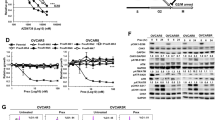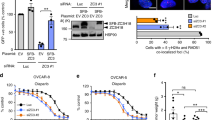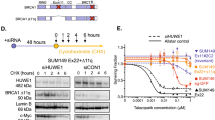Abstract
BRCA1, the gene responsible for approximately half of all cases of hereditary breast cancer and almost all cases of combined hereditary breast and ovarian cancer, has been implicated in the maintenance of genomic stability through DNA repair. This function is mediated, at least in part, through two tandem BRCA1 C-terminal (BRCT) repeats. The role of BRCA1 in the development of ovarian cancer is poorly understood, partially owing to the lack of ovarian cancer cell lines with defective BRCA1. The purpose of this study was to further characterize an endometrioid ovarian cancer cell line, SNU-251, which was previously reported to carry a nonsense mutation (from G to A) at amino acid 1815 of BRCA1. In addition, we examined the role of BRCA1 in the cell cycle and in the responses to the chemotherapy drug paclitaxel and ionizing radiation. Loss of the C-terminal 49 amino acids due to this point mutation did not affect the expression of the truncated BRCA1 protein, but caused a loss of transcriptional activation of the endogenous p21WAF1/CIP1 gene, and could not sustain arrest in the G2/M phase of the cell cycle. The BRCA1 mutation in SNU-251 cells inhibited BRCA1 subnuclear assembly for DNA-damage repair and increased cellular sensitivity to ionizing radiation and paclitaxel. This sensitivity was reversed by reintroduction of ectopic wild-type BRCA1. Our results suggest that the deletion of the C-terminal 49 amino acids of BRCA1 results in a loss of BRCA1 function in the SNU-251 cell line. BRCA1 helps to mediate the resistance to both radiation and paclitaxel. Therefore, SNU-251 may be a useful model for studying the molecular mechanism of BRCA1 in the resistance of ovarian cancer to ionizing radiation and chemotherapy treatment and in the development of hereditary human ovarian cancer.
This is a preview of subscription content, access via your institution
Access options
Subscribe to this journal
Receive 50 print issues and online access
$259.00 per year
only $5.18 per issue
Buy this article
- Purchase on Springer Link
- Instant access to full article PDF
Prices may be subject to local taxes which are calculated during checkout






Similar content being viewed by others
References
Bork P, Hofmann K, Bucher P, Neuwald AF, Altschul SF and Koonin EV . (1997). FASEB J., 11, 68–76.
Callebaut I and Mornon JP . (1997). FEBS Lett., 400, 25–30.
Chai YL, Cui J, Shao N, Shyam E, Reddy P and Rao VN . (1999). Oncogene, 18, 263–268.
Chen JJ, Silver D, Cantor S, Livingston DM and Scully R . (1999). Cancer Res., 59, 1752s–1756s.
Chen PL, Chen CF, Chen Y, Xiao J, Sharp ZD and Lee WH . (1998). Proc. Natl. Acad. Sci. USA, 95, 5287–5292.
Chen Y, Farmer AA, Chen CF, Jones DC, Chen PL and Lee WH . (1996). Cancer Res., 56, 3168–3172.
Cortez D, Wang Y, Qin J and Elledge SJ . (1999). Science, 286, 1162–1166.
Dulic V, Stein GH, Far DF and Reed SI . (1998). Mol. Cell. Biol., 18, 546–557.
Easton DF, Bishop DT, Ford D and Crockford GP . (1993). Am. J. Hum. Genet., 52, 678–701.
el-Deiry WS, Tokino T, Velculescu VE, Levy DB, Parsons R, Trent JM, Lin D, Mercer WE, Kinzler KW and Vogelstein B . (1993). Cell, 75, 817–825.
Harper JW, Adami GR, Wei N, Keyomarsi K and Elledge SJ . (1993). Cell, 75, 805–816.
Kim NW and Wu F . (1997). Nucleic Acid Res., 25, 2595–2597.
Liu J, Prolla G, Rostagno A, Chiarle R, Feiner H and Inghirami G . (2000). Oncogene, 19, 2767–2773.
Monteiro AN, August A and Hanafusa H . (1996). Proc. Natl. Acad. Sci. USA, 93, 13595–13599.
Ouchi T, Monteiro AN, August A, Aaronson SA and Hanafusa H . (1998). Proc. Natl. Acad. Sci. USA, 95, 2302–2306.
Park JG . (2002). Gan to Kagaku Ryoho [J. J. Cancer Chemother.], 29 Suppl 1, 89–98.
Risinger JI, Umar A, Boyd J, Berchuck A, Kunkel TA and Barrett JC . (1996). Nat. Genet., 14, 102–105.
Sato N, Tsunoda H, Nishida M, Morishita Y, Takimoto Y, Kubo T and Noguchi M . (2000). Cancer Res., 60, 7052–7056.
Scully R, Chen J, Ochs RL, Keegan K, Hoekstra M, Feunteun J and Livingston DM . (1997a). Cell, 90, 425–435.
Scully R, Chen J, Plug A, Xiao Y, Weaver D, Feunteun J, Ashley T and Livingston DM . (1997b). Cell, 88, 265–275.
Scully R, Ganesan S, Brown M, De Caprio JA, Cannistra SA, Feunteun J, Schnitt S and Livingston DM . (1996). Science, 272, 123–126.
Scully R, Ganesan S, Vlasakova K, Chen J, Socolovsky M and Livingston DM . (1999). Mol. Cell, 4, 1093–1099.
Somasundaram K, MacLachlan TK, Burns TF, Sgagias M, Cowan KH, Weber BL and el-Deiry WS . (1999). Oncogene, 18, 6605–6614.
Somasundaram K, Zhang H, Zeng YX, Houvras Y, Peng Y, Wu GS, Licht JD, Weber BL and El-Deiry WS . (1997). Nature, 389, 187–190.
Steck PA, Pershouse MA, Jasser SA, Yung WK, Lin H, Ligon AH, Langford LA, Baumgard ML, Hattier T, Davis T, Frye C, Hu R, Swedlund B, Teng DH and Tavtigian SV . (1997). Nat. Genet., 15, 356–362.
Sun H, Enomoto T, Fujita M, Wada H, Yoshino K, Ozaki K, Nakamura T and Murata Y . (2001). Am. J. Clin. Pathol., 115, 32–38.
To MD, Done SJ, Redston M and Andrulis IL . (1998). Am. J. Pathol., 153, 47–51.
Tomlinson GE, Chen TT, Stastny VA, Virmani AK, Spillman MA, Tonk V, Blum JL, Schneider NR, WistubaII, Shay JW, Minna JD and Gazdar AF . (1998). Cancer Res., 58, 3237–3242.
Xu X, Wagner KU, Larson D, Weaver Z, Li C, Ried T, Hennighausen L, Wynshaw-Boris A and Deng CX . (1999a). Nat. Genet., 22, 37–43.
Xu X, Weaver Z, Linke SP, Li C, Gotay J, Wang XW, Harris CC, Ried T and Deng CX . (1999b). Mol. Cell, 3, 389–395.
Yan T, Schupp JE, Hwang HS, Wagner MW, Berry SE, Strickfaden S, Veigl ML, Sedwick WD, Boothman DA and Kinsella TJ . (2001). Cancer Res., 61, 8290–8297.
Yuan Y, Kim WH, Han HS, Lee JH, Park HS, Chung JK, Kang SB and Park JG . (1997). Gynecol. Oncol, 66, 378–387.
Zhang H, Somasundaram K, Peng Y, Tian H, Bi D, Weber BL and El-Deiry WS . (1998). Oncogene, 16, 1713–1721.
Zhong Q, Chen CF, Li S, Chen Y, Wang CC, Xiao J, Chen PL, Sharp ZD and Lee WH . (1999). Science, 285, 747–750.
Acknowledgements
This work was supported in part by institutional start-up funds, an institutional research grant, and a career development award from MD Anderson Cancer Center Specialized Program of Research Excellence (SPORE) in Ovarian Cancer (to JL). CZ is the recipient of a postdoctoral fellowship from the United State's Army Breast Cancer Research Program (Department of Defense, Grant No. DAMD17-99-1-9264) and the MD Anderson Cancer Center SPORE in Ovarian Cancer. We thank Dr Jae-Gahb Park for SNU-251 cell, Dr Daniel Haber for BRCA1 cDNA and Dr Arnout C Ruifrok for help with imaging analysis.
Author information
Authors and Affiliations
Corresponding author
Rights and permissions
About this article
Cite this article
Zhou, C., Smith, J. & Liu, J. Role of BRCA1 in cellular resistance to paclitaxel and ionizing radiation in an ovarian cancer cell line carrying a defective BRCA1. Oncogene 22, 2396–2404 (2003). https://doi.org/10.1038/sj.onc.1206319
Received:
Revised:
Accepted:
Published:
Issue Date:
DOI: https://doi.org/10.1038/sj.onc.1206319
Keywords
This article is cited by
-
ATM-dependent activation of SIM2s regulates homologous recombination and epithelial–mesenchymal transition
Oncogene (2019)
-
Management of hereditary breast and ovarian cancer
International Journal of Clinical Oncology (2018)
-
RNA-seq profiling of a radiation resistant and radiation sensitive prostate cancer cell line highlights opposing regulation of DNA repair and targets for radiosensitization
BMC Cancer (2014)
-
Transformation of human ovarian surface epithelial cells by Krüppel-like factor 8
Oncogene (2014)
-
DNA-PKcs activates the Chk2–Brca1 pathway during mitosis to ensure chromosomal stability
Oncogenesis (2014)



